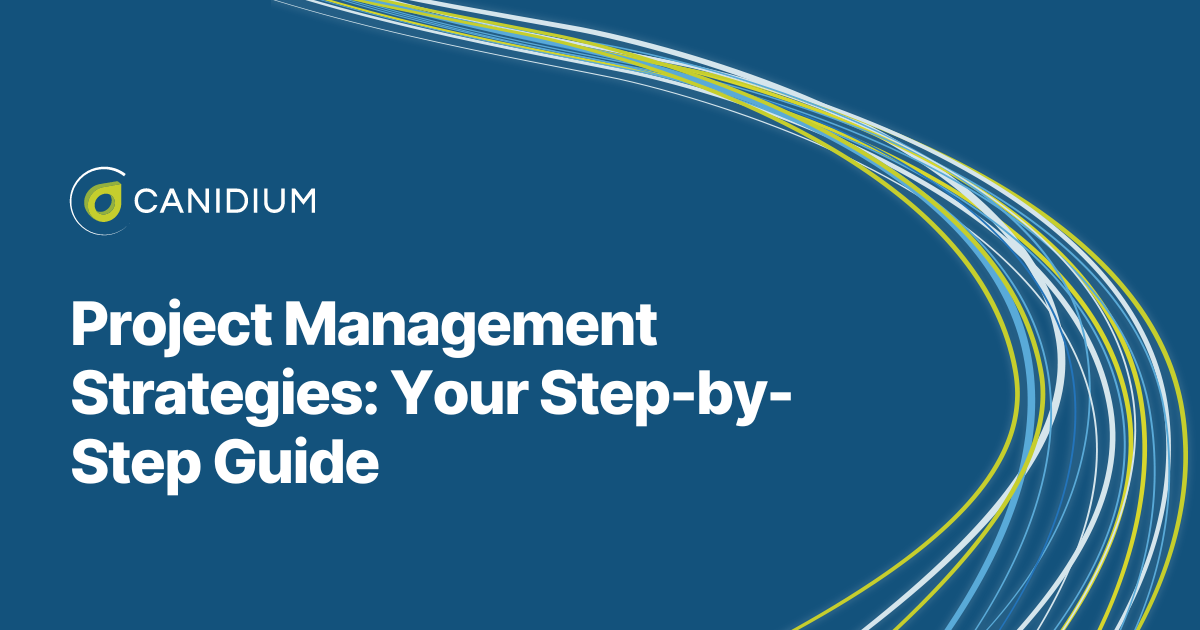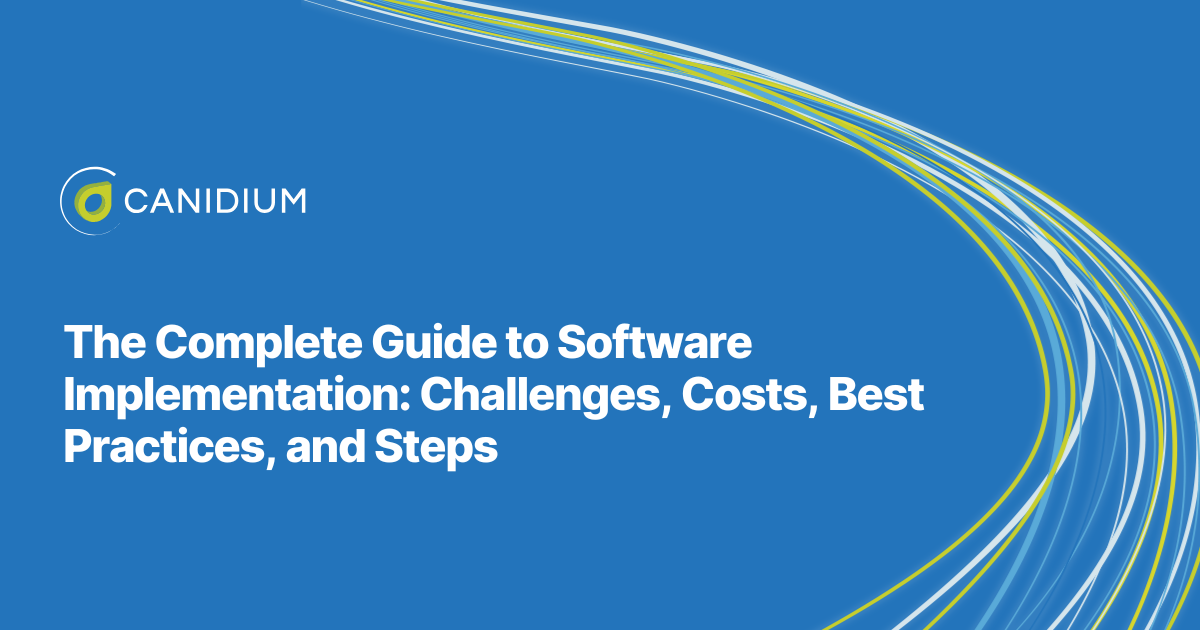As a project manager, it is hard to pinpoint the methodology that leads to success. There are always variables that can trip you up. Each project is different, forcing you to think on your feet, which is perhaps why 42% of project managers do not follow a defined methodology. However, this finding also notes that ad hoc approaches reduce their chances of success.
Where does this leave you? There is no singular formulaic approach, yet you need a methodology to facilitate repeatable success. For most project managers, the answer is found in project management strategies.
At Canidium, our dedicated software implementation teams oversee some of the industry's most rapid-paced, technically challenging implementation projects. Our project managers have extensive experience and have developed robust strategies and methodologies for dealing with prominent challenges.
This guide provides everything you need to know about common project management challenges. It offers step-by-step frameworks to improve your success rates under the following topics:
- Four project management challenges to watch out for
- Understanding your constraints: the project management iron triangle
- Step-by-step project management strategies: optimizing the process and overcoming challenges
4 Project Management Challenges to Watch Out For
Before developing your project management strategies, you need to understand the challenges you may encounter. Organizing resources and processes to avoid these challenges is a significant component of effective project management, so it is vital to comprehensively recognize the issues you may be facing.
The unique components of your project may give rise to some distinctive, singular challenges. However, project management challenges are generally predictable issues that planning can mitigate.
Here are the four most common project management challenges you should be aware of:
.png?width=1920&height=1080&name=4%20Project%20Management%20Challenges%20to%20Watch%20Out%20For%20(6).png)
1. Project Scope Creep
Scope creep is one of project managers' most prominent and persistent challenges. In fact, 50% of projects experience scope creep, with only 57% finishing within budget and 51% finishing on schedule.
Scope creep occurs when the project's boundaries expand beyond the original requirements without proper adjustments to resources, timelines, or budgets. This phenomenon often results in significant delays and budget overruns.
Beyond the obvious added costs and extended timelines that scope creep can cause, these issues can also compromise the quality of the original project objectives. The project team might have to cut corners to meet deadlines or stay within budget, leading to subpar results. In severe cases, scope creep can lead to project failure, making it impossible to deliver the intended outcomes within budget, time, and resource constraints.
2. Poorly Defined Communication Chains
You are probably familiar with the notion that clear communication improves project outcomes. However, most of us are unaware of communication's profound and measurable impact on project management success.
Businesses can increase the productivity of their knowledge workers by 20-25% simply by leveraging social technologies to create communication networks. Furthermore, 72% of business leaders believe that effective communication increases productivity.
Bearing these figures in mind, the importance of communication in project management is undeniable. Proper communication strategies facilitate greater productivity, but the inverse is also true. Poor communication between your team hinders progress through every phase of the project.
Inefficiencies and misunderstandings proliferate when there isn't a clear protocol for information flow among project stakeholders. Without clear communication pathways, messages can easily become distorted as they pass through multiple channels or are communicated informally. This can lead to misunderstandings about project requirements, status updates, and stakeholder expectations, causing confusion and errors in project execution.
Moreover, clear communication structures help in tracking responsibilities and accountabilities. Without these, it becomes difficult to pinpoint who is responsible for what task, leading to accountability issues where your team may overlook tasks.
3. Unexpected Project Changes
Changes to project scope or requirements are sometimes inevitable. Even the most thoroughly planned project can unexpectedly undergo significant changes through no fault of any parties involved.
As a project manager, you must have strategies to deal with the unexpected; otherwise, your team's success and product quality are at risk. Frequent and unmanaged changes can lead to confusion and frustration within the team. Without clear direction and constant adjustments, team members may feel their work is unproductive or futile, leading to decreased morale and lower productivity.
At the same time, changes in a project often bring additional challenges. Without a proactive approach to change management, these issues may not be identified or mitigated in time, potentially leading to critical failures or challenges in project delivery. Consequently, the final deliverables may not meet the stakeholders' expectations or requirements, leading to dissatisfaction and possibly affecting future investment or support.
Every change requires an assessment, decision-making, and implementation, which can be time-consuming. Without an effective strategy for managing these changes, the project can experience significant inefficiencies and delays, impacting the overall timeline and success.
4. Unclear Project Priorities
According to Project Management Institute (PMI) findings, the top three causes of scope creep are:
- Ambiguous or unrefined scope definition
- Lack of any formal scope or requirements management
- Inconsistent process for collecting product requirements
The common thread between these three issues is poorly defined project priorities. Without a clear understanding of what the project should achieve, additional features, functions, or changes will likely be added as stakeholders develop a better understanding of what they want over time. This gradual project expansion is often the impetus of scope creep, which subsequently causes budget overruns and timeline delays. To avoid scope creep, you must first address any unclear requirements.
Undefined requirements make it challenging to allocate resources effectively. Teams may spend time and effort working on low-priority features or on reworking elements of the project that were not adequately defined initially. This issue wastes resources, diverting them from more critical project components.
Uncertainty about requirements can lead to critical oversights in the planning and execution phases, increasing the risk that the project will fail to achieve its intended outcomes.
Understanding Your Constraints: The Project Management Iron Triangle
To be effective, your project management strategies must account for the interplay of constraints you are under. For example, you may need to expand the scope of your project, in which case you will likely have to alter the time and cost. Alternatively, reducing the time allocated for the project might require increasing the budget or reducing the scope. Finally, cutting costs could lead to a reduced scope or extended timelines. These factors are interdependent; altering one will impact the others.
This concept is known as the project management iron triangle. It outlines three critical constraints: scope, time, and cost. Here's a breakdown of each corner of the Iron Triangle:
.png?width=1920&height=1080&name=4%20Project%20Management%20Challenges%20to%20Watch%20Out%20For%20(7).png)
- Scope: This refers to the size and goals of the project and what needs to be accomplished. The scope encompasses all the work required to complete the project successfully, including the quality of the deliverables. Managing scope effectively prevents scope creep, ensuring that the project delivers what was agreed upon without adding additional features or functions that were not originally planned. Product quality is often considered a part of the project scope. Your internal team may overlook quality in favor of reducing costs or timelines. However, ensuring high quality is essential for delivering a successful project that meets or exceeds stakeholder expectations. Quality should be defined and managed from the beginning of the project and integrated into the processes set up during the initial requirements gathering and workshopping phase.
- Time: This is about the timeline for completing the project. Effective time management involves setting realistic deadlines, scheduling tasks, and ensuring the project progresses without unnecessary delays. Staying on schedule is crucial for maintaining stakeholder satisfaction and the project's success.
- Cost: Managing the budget involves ensuring that the project is completed within the financial constraints set at the beginning. It includes allocating resources efficiently and monitoring expenditures to avoid cost overruns.
Project management strategy involves maneuvering around the limits of these constraints to produce the highest-quality product. Every project carries risks, but you can anticipate potential issues by strategizing around known constraints and developing contingency plans. This proactive approach reduces the likelihood of project delays, cost overruns, and scope creep.
Download your guide to post-implementation challenges with ICM solutions
Step-by-Step Project Management Strategies: Optimizing the Process and Overcoming Challenges
While the iron triangle is an excellent way to strategize for unique or unexpected issues that crop up during the project, it should not be the sole methodology you rely on. You should have several project management strategies in place to establish a strong foundation for your team and mitigate the risks of encountering common pitfalls.
Here is a step-by-step guide to four strategic initiatives you can build into your project management roadmap to increase your success rates:
.png?width=1920&height=1080&name=4%20Project%20Management%20Challenges%20to%20Watch%20Out%20For%20(8).png)
Establish a Change Management Strategy Early On
Changes will likely occur as your project moves forward. As a project manager, this can make your job harder, but it does not have to. With the right strategies and processes, dealing with changes is routine.
Firstly, as you do not know when changes will occur, it is best to establish your change management processes as early as possible. Ideally, initiate this process during the sales cycle to ensure all parties are on the same page before the project begins. This early documentation of your change management plan will be a critical reference point throughout the project's lifecycle.
Start by detailing the procedures for handling change requests (CRs). Clearly define who can initiate changes, how these changes should be communicated, and the steps for approval. Incorporate tools and methodologies that allow for seamless tracking and implementation of changes. For example, project management software can provide real-time updates and maintain an audit trail of changes. This transparency helps ensure that all stakeholders know about modifications and their impacts on the project.
Moreover, train your team on the importance of this change management strategy. They should understand how to apply the process and why maintaining adherence is crucial for the project's success. This understanding helps minimize change resistance and ensures a smoother transition during adaptations.
Your proactive setup should include contingency plans for high-impact changes. By considering potential scenarios and their solutions in advance, you can reduce downtime and swiftly navigate challenges without significant disruptions. This readiness keeps your project on track and within the scope and budget, safeguarding against the spiraling costs often associated with poorly managed changes.
Define Your Strategic Project Management Communication Chain
Clear communication is often cited as a vital component of project management. Yet, this advice is hard for project managers to implement. What does clear communication look like? How do you foster robust communication within your project team? This advice falls short of explaining the mechanics of clarifying the communication lines for your team members.
You need a practical project management strategy you can follow to define the lines of communication within your team and thus encourage robust information sharing. More communication does not necessarily mean better communication. For instance, 19% of Gallagher's survey respondents reported that overcommunication hinders their success. The key is to find a balance, using project management strategies to ensure communication is direct, effective, and productive. To this end, you should establish an internal communication chain within your project team:
- Executive Sponsor: This role is responsible for strategic oversight and requires signing off on critical project milestones such as the design, build, UAT (User Acceptance Testing), and go-live stages. It is typically a high-level stakeholder with the authority to make key decisions and provide the necessary resources. By requiring the Executive Sponsor to sign off on critical project milestones, the project aligns with the organization's strategic goals. It ensures that top management remains informed and engaged with the project's progress.
- Internal Project Champion: This individual coordinates the efforts between the executive sponsor and the working team. They also define the involvement of Subject Matter Experts (SMEs). The Internal Project Champion bridges the gap between the Executive Sponsor and the operational project team. The Internal Project Champion is involved in every step of the project, allowing for seamless communication and coordination of efforts across different project segments. Their involvement ensures that the strategic directives from the Executive Sponsor are implemented tactically and effectively at the operational level. They also play a critical role in problem-solving and making tactical decisions that do not require the direct input of the Executive Sponsor but are crucial for the day-to-day management of the project.
- SMEs: These individuals provide the technical or domain-specific knowledge required at various project stages. SMEs provide the necessary depth of expertise to address complex challenges that arise during project execution, contributing to higher-quality outcomes and more efficient problem resolution. Their involvement ensures the project meets its technical requirements and adheres to industry standards.
This chain of command clarifies each team member's roles and communication responsibilities. It prevents overcommunication and confusion regarding role-specific tasks while supporting a cohesive team approach to the project.
Apply Project Management Strategies to the Initial Requirements Gathering and Workshopping
The initial stages of requirements gathering and workshopping are foundational to the success of any project. This critical phase involves identifying and defining the needs and expectations that the project must fulfill. To effectively manage this phase, it is essential to differentiate between the "must-haves" and "nice-to-haves." A practical approach is to use a rating scale from one to five, where stakeholders can assign a priority level to each requirement. This scale helps quantify the importance of each requirement, ensuring that the project team understands which features are essential to the project's success and which are less critical.
However, when rating project requirements, it is vital to weigh the importance of each item. Often, every item is rated as a "must-have," which undermines the point of the rating system and prevents you from strategically allocating resources. Some requirements are more critical than others, and the ratings should reflect this.
"It is important to note not everything can be a five; if everything's a five, nothing is a five." –Nic Widhalm, Canidium's Head of Salesforce Strategy.
During the project, when trade-offs are needed due to time or budget constraints, having a predefined priority scale makes these decisions more straightforward. Choices can be based on the impact on the project's critical path and primary goals rather than subjective interpretations of requirement importance.
Clearly defining what is essential at the outset also helps mitigate scope creep. As new features or changes are proposed, they can be evaluated against the established priorities. This ensures that any deviation from the original plan is justified, aligns with the overall project strategy, and does not merely add to the scope arbitrarily.
Conduct Weekly Status Meetings
Weekly status meetings are vital in project management to ensure continuous momentum and alignment among all project stakeholders. These meetings are a regular checkpoint to review the project's progress, identify and address emerging issues, and align on future steps.
Step-by-Step Guide to Effective Weekly Status Meetings:
- Progress Updates: Each meeting should begin with a status update detailing what has been accomplished since the last meeting. This helps keep the team on the same page and provides a clear picture of where the project stands concerning the planned timeline.
- Risk and Issue Discussion: An essential part of these meetings is the identification and discussion of new risks or issues that have emerged. Discussing these elements openly allows the team to collaboratively think through solutions and mitigation strategies, preventing potential roadblocks from escalating into more significant problems.
- Delivery Dates Confirmation: Confirming the delivery dates for different project components during these meetings ensures that all team members are aware of deadlines and can adjust their work plans accordingly. It also allows for re-evaluating timelines based on the current project status, ensuring that schedules remain realistic and achievable.
- Technology Integration: Facilitating these meetings with project management software can significantly enhance their effectiveness. Software like Cloud Coach or similar tools offers real-time updates and comprehensive visibility into project metrics and milestones. This technology supports transparency, enabling all stakeholders to access the same information immediately, facilitating more informed decision-making and timely adjustments to the project plan.
- Focused Discussions: It is crucial to keep the meetings productive by focusing on the agenda. Discussions should be specific to the status updates, risks, and necessary decisions to keep the project moving forward. This focus prevents the meeting from veering off-topic and ensures that time is used efficiently.
- Stakeholder Engagement: Regularly involve key stakeholders in these meetings to maintain their engagement and investment in the project's success. Their input can provide valuable insights and help make informed strategic decisions, especially when adjustments are needed.
- Action Items and Follow-ups: Conclude each meeting with a clear list of action items and responsibilities assigned to specific team members. This practice helps ensure accountability, and everyone leaves the meeting understanding their next steps. Additionally, follow up on previous action items at the beginning of each meeting to ensure that tasks are being completed as expected.
By conducting structured weekly status meetings that focus on these critical components, you can maintain a disciplined approach to project management. This routine helps preemptively address potential issues, adjust strategies as needed, and ensure the project remains on track to meet its objectives efficiently and effectively.
Implementing Successful Project Management Strategies
Effective project management is essential for successful outcomes, and you need strategies to reliably oversee the production of quality products. Start by establishing a change management strategy early in the sales cycle and maintaining it throughout the project's lifecycle. This approach helps you handle changes efficiently, reducing disruptions and preserving the integrity of your project.
Ensure clear and well-structured communication within your project team. A strategic communication chain involving an executive sponsor, an internal project champion, and subject matter experts ensures that information flows effectively, preventing misunderstandings and aligning all team members with the project goals.
Use a rating system during initial workshops to prioritize 'must-haves' versus 'nice-to-haves.' This helps focus resources on essential features, control scope creep, and align the project with its intended outcomes. At the same time, weekly status meetings should keep all stakeholders informed and engaged, allow for early risk identification and mitigation, and ensure the project stays on track.
These strategies create a disciplined, responsive environment that adapts to challenges and optimizes outcomes. Implement these practices to enhance your effectiveness as a project manager and lead your team to successful outcomes.
Now that you have a strong grasp of the foundational project management strategies, your next step is to learn how to successfully navigate complex projects like software implementations. Start by discovering the three problems to avoid when working with software implementation partners.








